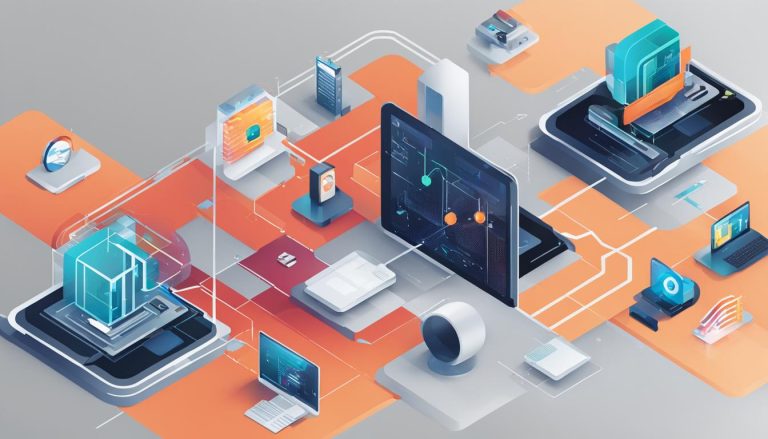When it comes to building applications that interact with REST APIs, developers often rely on a framework called Swagger, also known as the OpenAPI Specification (OAS). This powerful tool defines how to communicate with an API, what information can be requested, and what information can be returned. With Swagger, developers can simplify API integration, eliminate guesswork, and improve the overall efficiency of their applications.
The OpenAPI Specification is a language-agnostic framework that allows both machines and human users to understand service capabilities without the need for additional documentation or access to source code. By providing a single source of truth, developers can eliminate misalignment between server-side and client-side APIs, making collaboration and changes more efficient.
Key Takeaways
- The OpenAPI Specification, also known as Swagger, is a framework for building applications that interact with REST APIs.
- It defines how to communicate with an API, what information can be requested, and what information can be returned.
- The OpenAPI Specification is language agnostic and allows both machines and human users to understand service capabilities without additional documentation or source code access.
- API specifications are typically written in YAML or JSON and include endpoints, authentication methods, operation parameters, contact information, and more.
- Swagger is a set of open-source tools built around the OpenAPI Specification that helps with designing, building, documenting, and consuming REST APIs.
What is Swagger and OpenAPI?
Swagger is a set of open-source tools built around the OpenAPI Specification (OAS) that helps with designing, building, documenting, and consuming REST APIs. It includes tools such as Swagger Editor, Swagger UI, and Swagger Codegen. The OpenAPI Specification is a machine-readable format for describing REST APIs, including available endpoints, operations, parameters, authentication methods, and other information. It can be written in YAML or JSON format. Swagger tools are not the only ones available for implementing the OAS, but they are widely used and can generate documentation, code, and test cases based on interface files.
When it comes to understanding Swagger and OpenAPI, it’s important to note that Swagger refers to the toolset developed by Smartbear Software for implementing the OpenAPI Specification. While Swagger tools are popular and widely used in the industry, there are other tools available for implementing the OpenAPI Specification as well. These tools, including Swagger Editor, Swagger UI, and Swagger Codegen, provide developers with the means to design, build, document, and consume REST APIs with ease.
By leveraging Swagger and the OpenAPI Specification, developers can streamline the API development process and ensure consistency in API design and documentation. These tools simplify the generation of documentation, code, and test cases based on the API specifications, making it easier for developers to consume and integrate APIs into their applications.
Benefits of Using the OpenAPI Specification
The OpenAPI Specification (OAS), also known as Swagger, offers a range of benefits for developers and businesses. Understanding these advantages can help you leverage the power of this industry-standard technology.
Improved API Consistency and Reliability
By using the OpenAPI Specification, developers can ensure consistent communication between different components of an application. The OAS defines the structure and behavior of APIs, reducing misalignment between server-side and client-side implementations. This eliminates guesswork and reduces the risks of product malfunction, offering improved API stability and reliability.
Ease of Integration and Collaboration
One of the key benefits of the OpenAPI Specification is its ability to simplify API integration. With a single specification file, developers can automatically generate API clients in multiple languages, eliminating the need for manual code implementation. The YAML and JSON formats used in the OAS are easy to read, modify, and discuss, facilitating collaboration and efficient changes within development teams.
Better Documentation and Client Testing
With the OpenAPI Specification, you can generate accurate and up-to-date API documentation automatically. This documentation serves as a single source of truth, providing a complete overview of the API structure, available endpoints, input parameters, and more. Developers can import the specification into clients for manual testing and ensure verification against the provided documentation, enhancing the overall quality and efficiency of the development process.
Streamlined API Development and Implementation
Implementing the OpenAPI Specification can significantly streamline API development and implementation. The OAS offers a standardized approach to designing, building, and documenting REST APIs. It helps developers adhere to best practices, simplifies the process of integrating APIs with other services, and reduces the need for writing boilerplate code. The OpenAPI Specification is widely adopted and supported by a variety of tools and frameworks, making it easy to incorporate into your development workflow.
Table: Benefits of Using the OpenAPI Specification
| Benefit | Description |
|---|---|
| Improved API Consistency and Reliability | Reduces misalignment between server-side and client-side APIs, ensuring consistent and reliable communication. |
| Ease of Integration and Collaboration | Allows for automatic generation of API clients in multiple languages, simplifying integration and facilitating collaboration. |
| Better Documentation and Client Testing | Enables the automatic generation of accurate and up-to-date API documentation, facilitating manual testing and verification. |
| Streamlined API Development and Implementation | Simplifies the process of designing, building, and documenting REST APIs, reducing boilerplate code and improving efficiency. |
How Different Industries Benefit from OpenAPI Technology
OpenAPI technology is widely used across various industries to streamline API development and implementation. Let’s explore some examples of how different sectors leverage the power of OpenAPI to enhance their operations.
1. eCommerce
In the eCommerce sector, businesses can rapidly scale their services and implement open-source design frameworks for API development. By leveraging OpenAPI technology, eCommerce platforms can ensure seamless integration with third-party applications, enabling efficient inventory management, order processing, and payment solutions. OpenAPI allows for easy collaboration between developers, accelerates the launch of new features, and simplifies the documentation process, ensuring that developers have clear guidelines for utilizing the platform’s API functionalities.
2. Media
The media industry, including platforms like Twitter, heavily relies on the OpenAPI specification to distribute information efficiently. OpenAPI enables media companies to provide comprehensive programmatic access to their content, allowing developers to build applications that leverage the platform’s vast amount of data. Media organizations can use OpenAPI-powered APIs to enable seamless integration with external services, facilitate content sharing, and enhance user engagement.
3. Open Government Initiatives
Open government initiatives use OpenAPI technology to provide open data through APIs, enabling new ways of accessing government functions. By adopting the OpenAPI specification, government agencies can offer standardized APIs for accessing public data related to healthcare, transportation, weather, and more. These APIs empower developers to create innovative applications that benefit citizens, improve transparency, and foster civic engagement.
These are just a few examples of how various industries benefit from OpenAPI technology. By leveraging the power of the OpenAPI specification, businesses and organizations can enhance collaboration, streamline API development, and promote interoperability between different systems and platforms.
Understanding the OpenAPI and Swagger Relationship
To fully grasp the relationship between OpenAPI and Swagger, we need to distinguish between the specification, the tools, and the users. OpenAPI refers to the standard specification itself, originally developed by Smartbear Software and currently overseen by the OpenAPI Initiative. On the other hand, Swagger is a renowned set of tools created by Smartbear Software for implementing the OpenAPI specification.
The Swagger tools, including Swagger Editor, Swagger UI, and Swagger Codegen, are widely used to design, build, document, and consume REST APIs. While these tools were developed in conjunction with the OpenAPI specification, it’s important to note that there are other options available for implementing the specification as well.
The OpenAPI Initiative collaborates with various organizations to foster the development of the specification and its associated tools. Together, OpenAPI and Swagger play a crucial role in streamlining API development and empowering developers to build robust and efficient REST APIs.
Clearing the Confusion: OpenAPI vs. Swagger
“OpenAPI refers to the specification, while Swagger represents the popular toolset that helps implement the OpenAPI specification.”
By understanding the distinction between OpenAPI and Swagger, developers can leverage the right tools to design, build, document, and consume REST APIs effectively. Whether you choose to utilize Swagger or explore other options for implementing the OpenAPI specification, the goal remains the same: to create reliable, standardized, and well-documented APIs.
OpenAPI Specification Version and Format
The OpenAPI Specification is versioned using a major.minor.patch scheme, with the current version being 3.1.0. This versioning system allows for easy identification of the feature set provided by the specification. Developers can refer to the version number to understand the capabilities and compatibility of the OpenAPI Specification they are working with.
The OpenAPI Specification supports two formats, JSON and YAML. While JSON is a popular format for machine-readable data interchange, YAML offers human-readable and user-friendly syntax. The YAML format, specifically version 1.2, is recommended for writing OpenAPI documents due to its simplicity, readability, and ease of modification. Developers can choose the format that best suits their preferences and requirements.
“The OpenAPI Specification is constantly evolving to meet the changing needs of the API community. New versions may introduce non-backwards compatible changes, but these changes are carefully managed to minimize disruption to existing implementations.”
| Major Version | Minor Version | Patch Version | Release Date |
|---|---|---|---|
| 3 | 1 | 0 | June 2021 |
| 3 | 0 | 2 | December 2020 |
| 3 | 0 | 0 | July 2017 |
| 2 | 0 | 0 | November 2014 |
The data above shows a brief history of the major versions of the OpenAPI Specification, along with their respective minor and patch versions and release dates. It highlights the evolution of the specification over time, demonstrating the commitment to providing improved functionalities and addressing the needs of developers.
The OpenAPI Specification, with its defined versioning scheme and support for different formats, ensures that developers can accurately describe and document their APIs in a standardized manner. The evolving nature of the specification allows for the integration of new features while maintaining compatibility with existing implementations.
Data Types, Media Types, and Document Structure in OpenAPI
In the OpenAPI Specification, data types are defined according to the JSON Schema Specification Draft 2020-12. This allows for the precise definition of various data types that can be used in API requests and responses. Some of the commonly used data types include:
- integer: Represents whole numbers, both positive and negative.
- number: Represents floating-point numbers.
- string: Represents a sequence of characters.
- boolean: Represents either true or false.
- array: Represents an ordered list of values.
- object: Represents a collection of key-value pairs.
These data types provide the necessary structure for defining the parameters, responses, and request bodies in an OpenAPI document.
Media types, on the other hand, specify the format of the API response or request. They play a crucial role in determining how data is transmitted and interpreted. These media types are defined in compliance with RFC6838 and can include formats such as text/plain, application/json, application/xml, and more. By specifying the media type, developers can ensure that the API consumers understand the format in which the data is expected.
The OpenAPI document itself follows a specific structure. It is represented as a JSON object or YAML representation. The document consists of various sections, including:
- openapi: Specifies the version of the OpenAPI Specification.
- info: Provides general information about the API, such as title, version, and contact details.
- servers: Describes the servers where the API is hosted.
- paths: Defines the available API endpoints and their corresponding operations.
- components: Specifies reusable components used throughout the API.
This structured document format facilitates easy navigation and understanding of the API. It serves as a single source of truth for the API definition and can be used by various tools for documentation generation, code generation, testing, and more.
Table: Common OpenAPI Data Types
| Data Type | Description |
|---|---|
| integer | Represents whole numbers, both positive and negative. |
| number | Represents floating-point numbers. |
| string | Represents a sequence of characters. |
| boolean | Represents either true or false. |
| array | Represents an ordered list of values. |
| object | Represents a collection of key-value pairs. |
Conclusion
The OpenAPI Specification, also known as Swagger, is a powerful interface design tool for building applications that interact with REST APIs. It provides a standardized and machine-readable format for describing APIs, ensuring consistency, ease of integration, and better documentation.
The benefits of using the OpenAPI Specification range from improved API reliability to simplified API client generation. Multiple industries, including eCommerce, media, and open government, benefit from the technology.
By understanding the relationship between OpenAPI and Swagger, developers can leverage the right tools to design, build, document, and consume REST APIs. The OpenAPI Specification continues to evolve, embracing new features and ensuring interoperability across different programming languages and platforms.
FAQ
What is Swagger?
Swagger, now known as the OpenAPI Specification (OAS), is a framework used by developers to build applications that interact with REST APIs. It provides a standardized format for defining how to communicate with an API, what information can be requested, and what information can be returned.
What is the OpenAPI Specification?
The OpenAPI Specification (OAS) is a language agnostic framework that allows both machines and human users to understand service capabilities without additional documentation or source code access. It defines the structure of API specifications, including endpoints, authentication methods, operation parameters, contact information, and more.
What are the benefits of using the OpenAPI Specification?
The OpenAPI Specification provides a machine-readable and single source of truth for the API, allowing for easy import into clients for manual testing and verification. It reduces the risks of product malfunction by enabling comparison of incoming and outgoing traffic against the API specifications. It simplifies API integration and allows for automatic generation of API clients in multiple languages, reducing boilerplate code. The YAML and JSON formats used in the OAS are easy to read, modify, and discuss, making collaboration and changes more efficient.
How do different industries benefit from OpenAPI technology?
OpenAPI technology benefits various industries. In eCommerce, it helps businesses rapidly scale services and implement open source design frameworks for API development. The media industry, such as platforms like Twitter, utilizes OpenAPI to distribute information efficiently. Open government initiatives use OpenAPI to provide open data through APIs, enabling new ways of accessing government functions. Accurate and up-to-date documentation is crucial for API developers, and the OAS simplifies the documentation generation process, ensuring alignment with the API architecture.
What is the relationship between OpenAPI and Swagger?
The OpenAPI Specification refers to the specification standard itself, while Swagger is a set of open-source tools built around the OpenAPI Specification. Swagger tools, including Swagger Editor, Swagger UI, and Swagger Codegen, help with designing, building, documenting, and consuming REST APIs. While Swagger tools were created in conjunction with the specification, there are other tools available for implementing the OpenAPI Specification. The OpenAPI Initiative collaborates with various organizations to foster the development of the specification and its associated tools.
What is the current version and format of the OpenAPI Specification?
The current version of the OpenAPI Specification is 3.1.0. The specification can be represented in either JSON or YAML format. It is recommended to use YAML version 1.2 for easy readability and modification. The OpenAPI document serves as a single source of truth for the API and is used by documentation generation tools, code generation tools, testing tools, and other use cases.
What data types, media types, and document structure are used in the OpenAPI Specification?
The OpenAPI Specification follows the types supported by the JSON Schema Specification Draft 2020-12 for defining data types. Media types, defined in compliance with RFC6838, specify the format of the API response or request. The OpenAPI document itself is a JSON object or YAML representation, with fixed fields like openapi, info, servers, paths, components, and more. The document structure can be a single document or divided into multiple connected parts, allowing for flexibility in organization and use.
What is the OpenAPI Specification’s role in interface design?
The OpenAPI Specification, also known as Swagger, is a powerful interface design tool for building applications that interact with REST APIs. It provides a standardized and machine-readable format for describing APIs, ensuring consistency, ease of integration, and better documentation. By utilizing the OpenAPI Specification, developers can design, build, document, and consume REST APIs more efficiently.
Cathy is a senior blogger and editor in chief at text-center.com.


